Physical Address
304 North Cardinal St.
Dorchester Center, MA 02124
The kidneys lie posteriorly in the abdomen, retroperitoneally on either side of the spine at the T12–L3 level, and are 11–14 cm long ( Fig. 12.1 ). The right kidney lies 1.5 cm lower than the left because of the liver. The liver and spleen lie anterior to the kidneys. The kidneys move downwards during inspiration as the lungs expand.
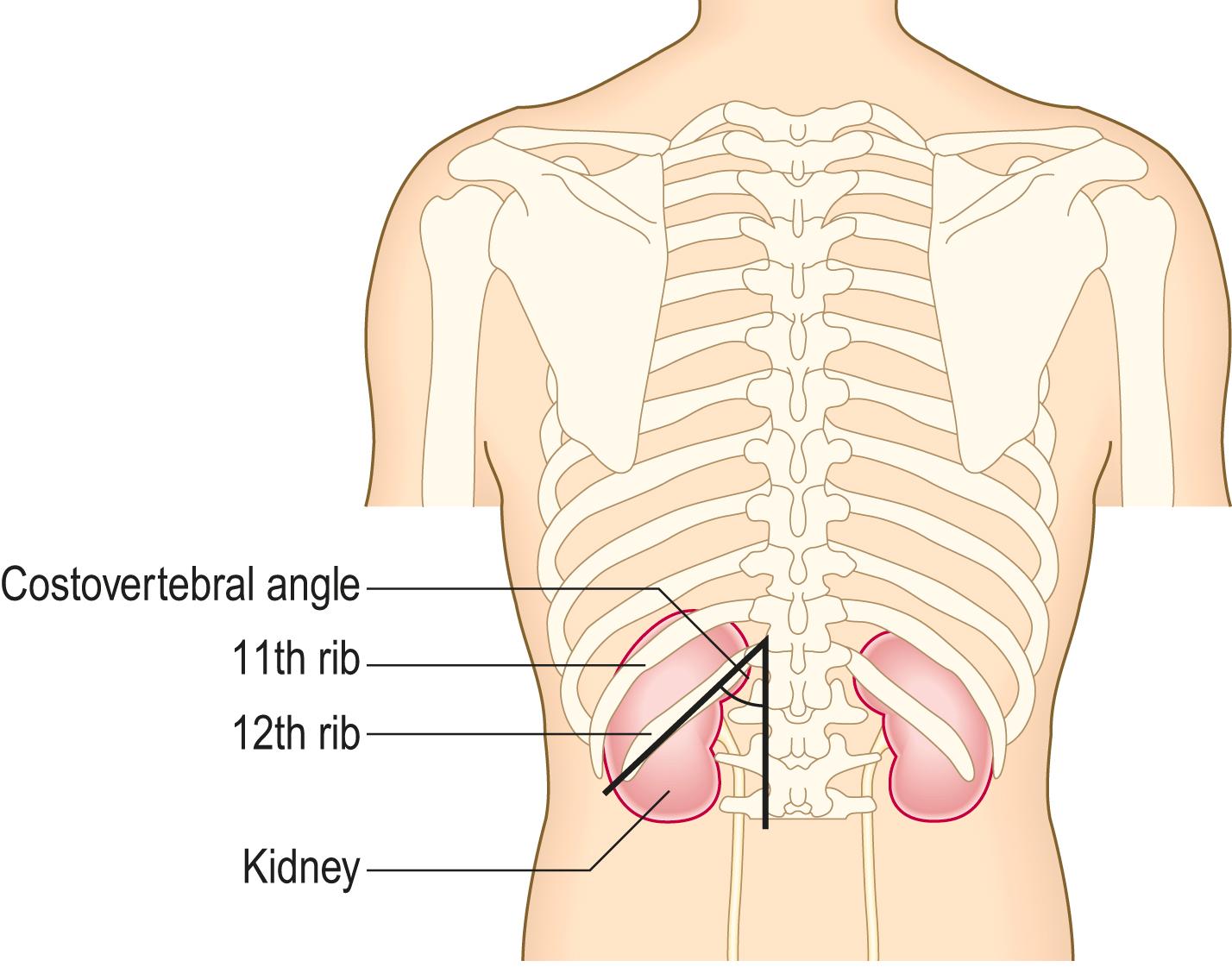
Together, the kidneys receive approximately 25% of cardiac output, and account for nearly 10% of basal metabolic rate. Each kidney contains about 1 million nephrons, each comprising a glomerulus, proximal tubule, loop of Henle, distal tubule, and collecting duct ( Fig. 12.2 ). Urine is formed by glomerular filtration, modified by complex processes of secretion and reabsorption in the tubules and then enters the calyces and the renal pelvis.
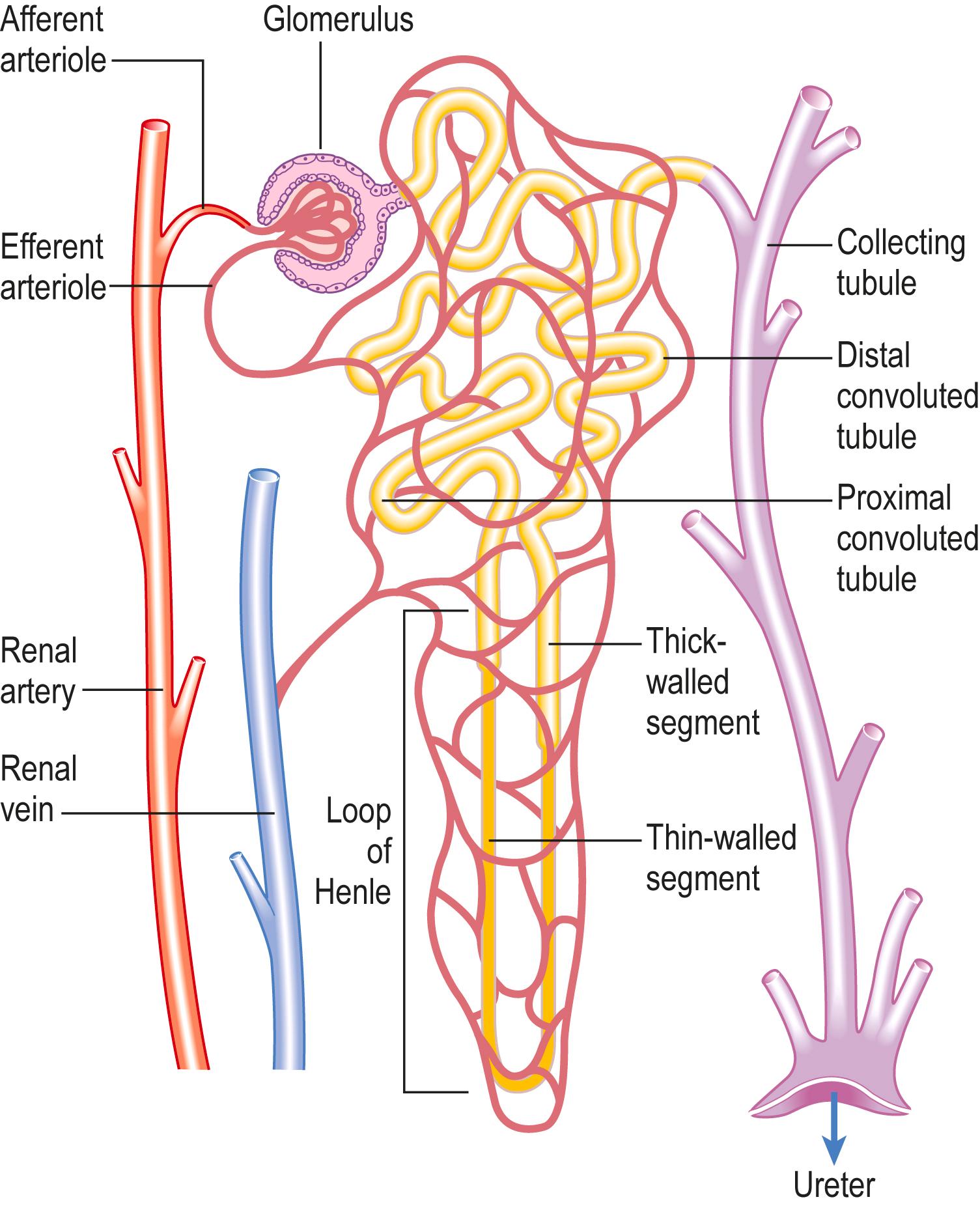
The primary functions of the kidneys are:
Excretion of waste products of metabolism, such as urea and creatinine
Maintenance of salt, water, and electrolyte homeostasis
Regulation of blood pressure via the renin–angiotensin-aldosterone system
Endocrine functions related to erythropoiesis and vitamin D metabolism
The renal capsule and ureter are innervated by T10–12/L1 nerve roots; pain from these structures is felt in these dermatomes.
The bladder acts as a reservoir. As it fills, it becomes ovoid and rises out of the pelvis in the midline towards the umbilicus, behind the anterior abdominal wall. The bladder wall contains a layer of smooth muscle, the detrusor, which contracts under parasympathetic control, allowing urine to pass through the urethra (micturition). The conscious desire to micturate occurs when the bladder holds approximately 250–350 mL of urine. The male urethra runs from the bladder to the tip of the penis and has three parts: prostatic, membranous and spongiose ( Fig. 12.3 ). The female urethra is much shorter, with the external meatus situated anterior to the vaginal orifice and behind the clitoris ( Fig. 12.4 ). Two muscular rings acting as valves (sphincters) control micturition:
The internal sphincter is at the bladder neck and involuntary.
The external sphincter surrounds the membranous urethra and is under voluntary control; it is innervated by the pudendal nerves (S2–4).
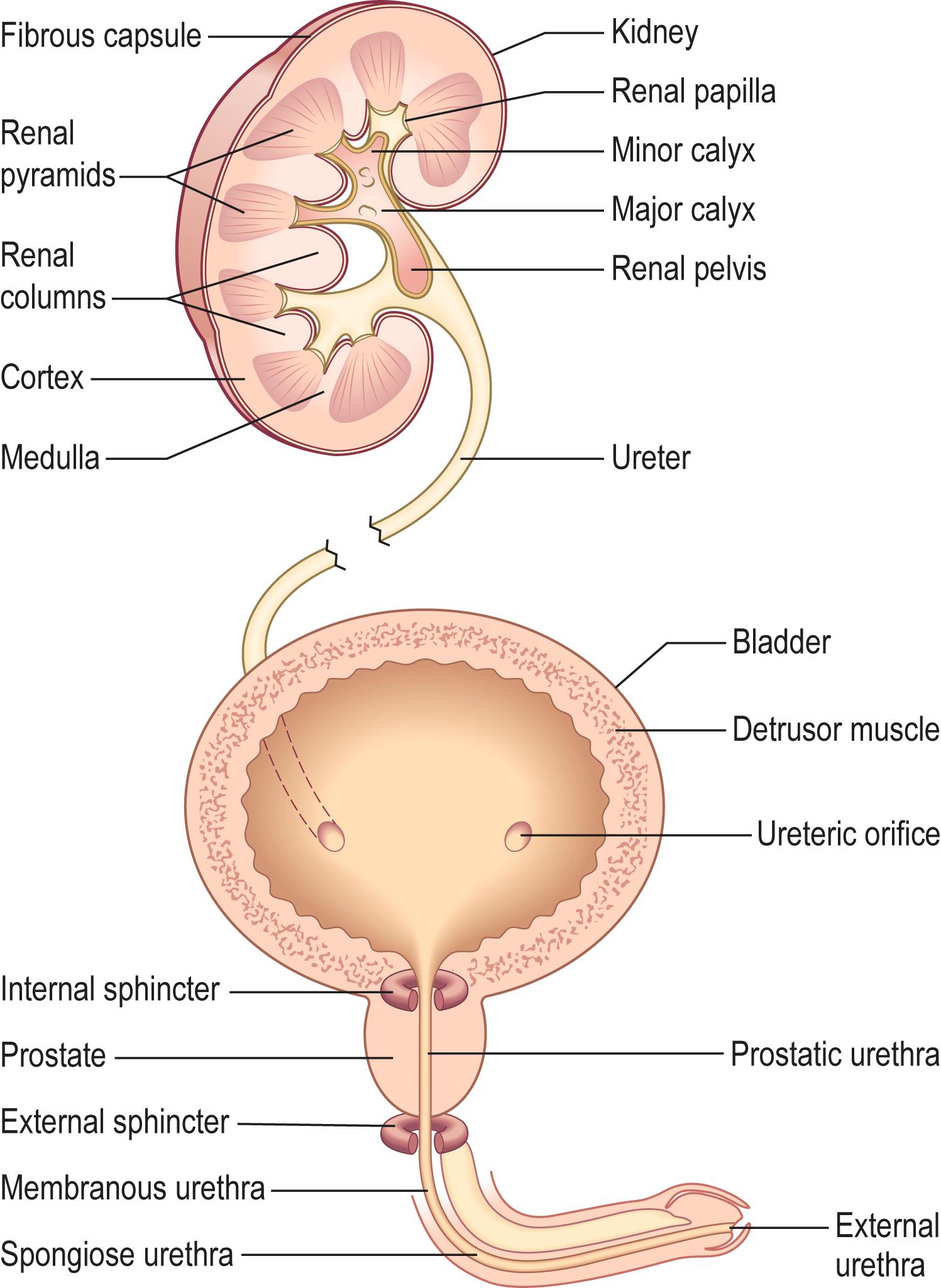
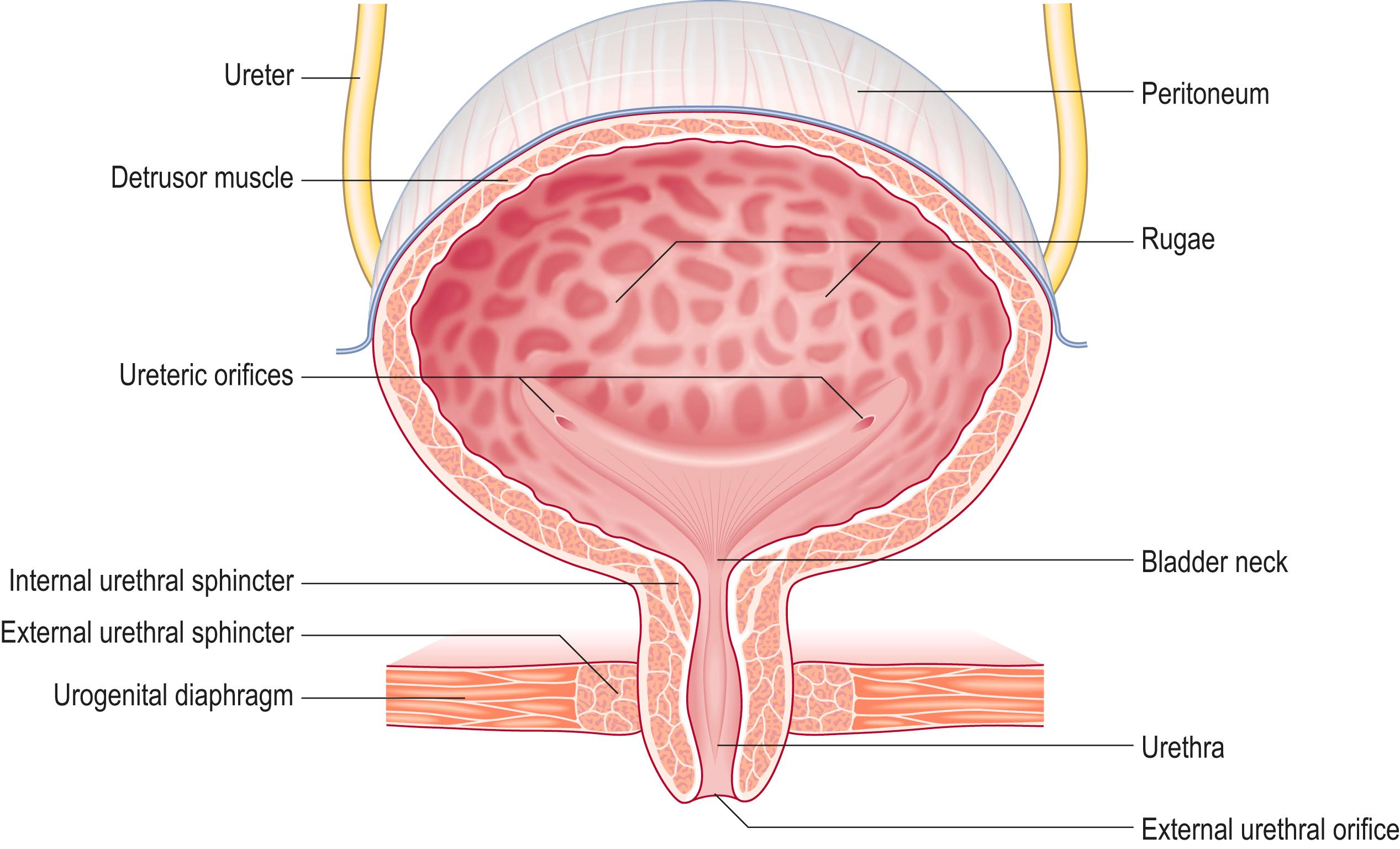
The anatomy and physiology of the prostate are covered in more detail on page 268.
Renal disease may be asymptomatic, or present with non-specific symptoms, such as lethargy or breathlessness. It is usually only after initial investigation that the history-taking can be focused on the possible renal causes.
Dysuria (pain or discomfort during urination) is a common symptom of urinary tract infection (UTI). There is usually associated urinary frequency, urgency and suprapubic discomfort (cystitis). Other causes include urethritis and acute prostatitis (which may be associated with severe perineal or rectal pain).
Ask about:
Systemic upset with fever and suprapubic discomfort. Pyelonephritis is suggested by a history of significant fever (>38.0°C), rigors, vomiting and flank pain. There may not always be symptoms of a preceding UTI.
Symptoms of urine outflow obstruction (slow flow, hesitancy, incomplete emptying, dribbling, nocturia).
History of sexual contacts.
Severe loin pain is usually due to ureteric obstruction; renal calculi are the most common cause. The pain often comes in waves and is described as ‘colicky’. The patient is unable to find a comfortable position and will move around the bed (unlike a patient with peritonism, who lies still).
Ask about:
Location of the pain: Is it just in the loin (pelvic/upper ureter obstruction), or does it radiate into the testicle or labium (lower ureter obstruction)?
Presence of fever, rigors and dysuria: these may suggest infection
Previous episodes of loin pain
Loin pain may also occur due to bleeding from a renal or ureteric tumour or due to infection. Non-renal causes of loin pain, such as a leaking aortic aneurysm (in older patients with vascular disease) and ectopic pregnancy (in women of child-bearing age), should be considered.
Symptoms are usually due to either bladder storage or voiding-phase problems.
Ask about:
Urgency, frequency, nocturia and urge incontinence (storage symptoms)
Hesitancy, poor stream, straining to void and terminal dribbling (voiding symptoms); these symptoms may be followed by a sense of incomplete emptying
Storage symptoms are usually associated with bladder, prostate or urethral problems, such as UTI, tumour, urethral calculi or obstruction from prostatic enlargement, or are caused by neurological disease, such as multiple sclerosis.
Voiding symptoms are often the result of bladder outflow obstruction from prostatic enlargement (in men) or urethral obstruction or genital prolapse (in women).
In women, incontinence is the most common symptom. Stress incontinence is urine leakage with increased abdominal pressure (such as when coughing or sneezing or due to weakened pelvic floor muscles), and urge incontinence is the urge to pass urine followed by involuntary leakage. These symptoms can occur separately or together, and increase with age. Overflow incontinence occurs without warning, often on changes in position, and is painless.
Polyuria, the passing of higher volumes of urine, has a number of causes, including excess water intake, osmotic diuresis (as in diabetes mellitus) and diabetes insipidus (inadequate secretion or action of vasopressin [antidiuretic hormone, ADH]).
Oliguria (passing of less than 500 mL of urine per day) and anuria (complete absence of urine) may be due to either very low fluid intake, mechanical obstruction or loss of kidney function (see later.)
Pneumaturia, passing gas bubbles in the urine, is suggestive of a fistula between the bladder and the colon from a diverticular abscess, malignancy or inflammatory bowel disease.
The presence of blood in the urine is common. It may either be seen by the patient (visible haematuria) or be identified by urinalysis or microscopy (non-visible).
Visible haematuria will be described as pink, red or brown in colour. Ask about previous episodes, their time course and whether they were persistent or intermittent. Haematuria can be due to an underlying problem anywhere along the renal tract from the glomerulus to the bladder ( Fig. 12.5 ). Immunoglobulin A (IgA) nephropathy is the most common glomerular cause, which is often preceded by a non-specific upper respiratory tract infection. The haematuria associated with bladder tumours is usually painless and intermittent. This is the most important cause to exclude in patients over 45 years of age without a UTI.
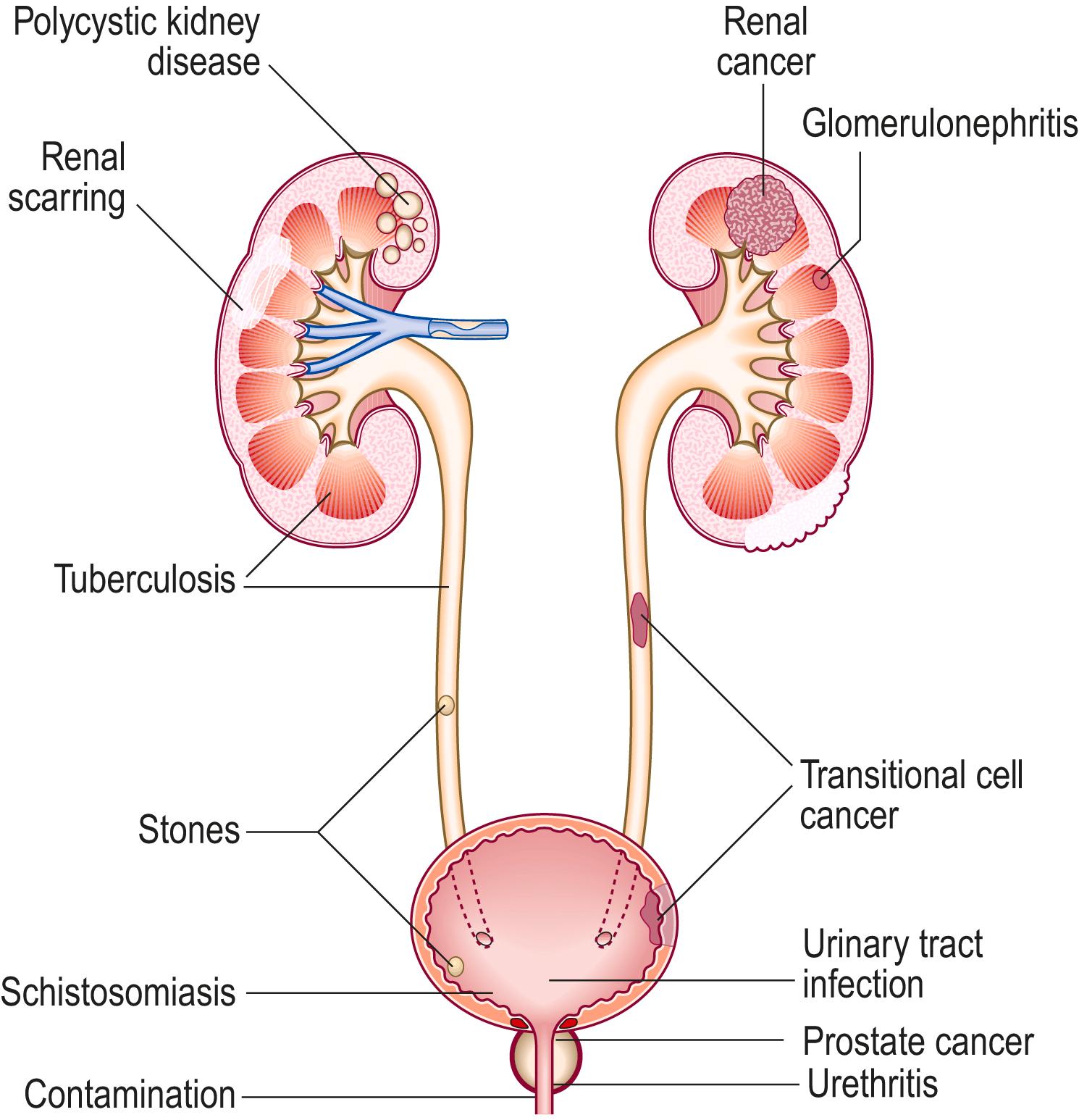
Ask about:
Loin pain, as this may indicate ureteric obstruction due to blood, calculi, or a tumour; flank pain and haematuria may be features of renal cell carcinoma.
Fever, dysuria, suprapubic pain and urinary frequency, which may indicate urinary infection.
Family history of renal disease; polycystic kidney disease can present with visible haematuria due to cyst rupture.
Non-visible (or microscopic) haematuria is a dipstick urinalysis abnormality, with 1+ considered positive. It can indicate renal or urinary tract disease. Non-visible haematuria in women of reproductive age is most commonly due to contamination by menstrual blood.
Proteinuria is the excretion of more than 150 mg of protein in the urine per day. It is usually asymptomatic but, if persistent, may indicate underlying renal disease.
Nephrotic syndrome is characterised by the combination of heavy proteinuria (>3.5 g/24 hours), hypoalbuminaemia and oedema. Nephrotic syndrome may come on over a few weeks (as in minimal change disease) and cause acute kidney injury (AKI), or it can evolve over many months (as in membranous nephropathy), giving a picture of chronic kidney disease (CKD). The most common cause of nephrotic syndrome is diabetes mellitus. Patients may notice that the urine is frothy due to the proteinuria; hyperlipidaemia, hypercoagulability, and an increased risk of infection may also develop.
Ask about:
Weight loss, altered bowel habit, cough, back pain or chronic inflammatory conditions such as rheumatoid arthritis, inflammatory bowel disease or bronchiectasis (in particular if undertreated). The latter cause nephrotic syndrome as a result of renal AA amyloid deposition.
Ankle swelling (pitting oedema): Younger patients may also notice facial swelling and puffy eyelids, especially first thing in the morning.
Breathlessness (pleural effusions).
Abdominal swelling (ascites).
AKI ( Box 12.1 ) covers a range of presentations from relatively mild changes in kidney function to dialysis-requiring kidney failure. The typical presentation is with a recently identified rise in serum creatinine. AKI may have prerenal, renal or postrenal causes ( Box 12.2 ); there is an increased risk in patients with pre-existing CKD. The history should focus on differentiating between these.
| RIFLE a AKIN b | Serum creatinine criteria | Urine output criteria |
|---|---|---|
| Risk AKIN stage 1 |
Increase>50% | < 0.5 mL/kg/h for 6 hours |
| Injury AKIN stage 2 |
Increase>100% | <0.5 mL/kg/h for 12 hours |
| Failure AKIN stage 3 |
Increase>200% or serum creatinine >350 μmol/L (3.96 mg/dL) | 0.3 mL/kg/h for 24 hours or anuria for 12 hours |
| Loss | Renal replacement therapy for >4 weeks | – |
| End-stage kidney disease | Renal replacement therapy for >3 months | – |
Hypovolaemia (e.g. blood loss, diarrhoea, vomiting, diuresis or inadequate oral intake)
Relative hypovolaemia (e.g. heart failure or nephrotic syndrome)
Sepsis
Drugs (e.g. antihypertensives, diuretics or non-steroidal anti-inflammatory drugs)
Renal artery stenosis or occlusion
Hepatorenal syndrome
Glomerular disease (e.g. immunoglobulin A nephropathy, systemic vasculitis or systemic lupus erythematosus)
Interstitial nephritis (drug-induced)
Acute tubular necrosis/injury (may follow a prerenal cause)
Multiple myeloma
Rhabdomyolysis
Intrarenal crystal deposition (e.g. urate nephropathy or ethylene glycol poisoning)
Thrombotic microangiopathy (e.g. haemolytic uraemic syndrome or scleroderma renal crisis)
Accelerated-phase hypertension
Cholesterol emboli
Renal stones (in papilla, ureter, or bladder)
Papillary necrosis
Ureteric or bladder transitional cell carcinoma
Intraabdominal or pelvic malignancy (e.g. cervical carcinoma)
Retroperitoneal fibrosis
Blood clot
Bladder outflow obstruction (e.g. prostatic enlargement)
Neurogenic bladder
Urethral stricture
Posterior urethral valves
Iatrogenic (e.g. ureteric damage at surgery, blocked urethral catheter)
This is almost always due to volume depletion (hypovolaemia).
Ask about:
Fluid losses, such as vomiting, diarrhoea or bleeding, and inadequate oral intake due to nausea or delirium.
Recent operations or investigations that may be associated with increased fluid losses or reduced intake (fasting, bowel preparation).
Any features of infection, such as fever, sweats, productive cough or dysuria.
Establish whether there is an underlying condition that may predispose to a reduction in renal blood flow.
Ask about:
History of heart failure or liver disease.
Recent drug prescriptions, such as those that block the renin–angiotensin-aldosterone system (e.g. angiotensin-converting enzyme inhibitors), other antihypertensive agents, diuretics (such as furosemide or spironolactone) and non-steroidal anti-inflammatory drugs (NSAIDs); NSAIDs can also cause intrinsic renal disease, such as interstitial nephritis and minimal change disease
The most common cause in the hospital setting will be acute tubular injury (ATI), which may lead to acute tubular necrosis (ATN). This usually follows renal hypoperfusion when any of the causes identified above results in ischaemia–reperfusion injury. A less common cause is rhabdomyolysis, which is suggested by a history of prolonged immobilisation, such as following a fall. ATI normally recovers, but this can take days to weeks. AKI can also be the first clinical presentation of a systemic disease that affects the kidney (such as myeloma, infective endocarditis, vasculitis or systemic lupus erythematosus).
Ask about:
Recent illnesses or operations.
Drug history and any recent changes in medications; several commonly prescribed medications (such as antibiotics, NSAIDs or proton pump inhibitors) are recognised as causing an allergic interstitial nephritis, but almost any drug can be implicated.
Symptoms of systemic disease: weight loss, fever, night sweats, tiredness, arthralgia, myalgia, bony pain, numbness, weakness, rashes, cough and breathlessness.
Occasionally, AKI can be the result of a primary glomerulonephritis. IgA nephropathy is the most common cause in the northern and western hemispheres. This classically presents with visible haematuria following an upper respiratory tract infection–so-called ‘synpharyngitic haematuria’.
Ask about:
Prior episodes.
Loin pain and haematuria.
Previous sore throat; a similar clinical illness can occur in postinfectious glomerulonephritis due to preceding beta-haemolytic streptococcal infection of the throat or skin.
This is usually due to any cause of obstruction from the renal pelvis to the urethra. The most common cause is bladder outflow obstruction; in men, this is often due to prostatic hypertrophy, either benign or malignant.
Ask about:
Urinary urgency, frequency, nocturia and incontinence.
Poor urine stream and terminal dribbling.
Previous prostatic assessments, including prostate examination and measurements of prostate-specific antigen.
Suprapubic pain.
Leg weakness, perineal numbness or faecal incontinence (may indicate a spinal cord lesion).
In acute urinary retention there is usually a complete inability to pass urine and associated suprapubic discomfort. Chronic urinary retention is usually painless.
For ureteric disease to cause AKI, both kidneys need to be affected (or the patient has a single functioning kidney). Ureteric obstruction is most commonly due to malignancy, such as that of the bladder, cervix, ovary or uterus. These conditions are usually painless. The history should explore any previous diagnosis and recent operations and treatment, including radiotherapy.
CKD is defined by degree of renal dysfunction and/or the presence of proteinuria ( Boxes 12.3 and 12.4 ); these need to be present for at least 3 months. The diagnosis of CKD therefore requires preceding biochemical data to enable its distinction from AKI. Most patients with CKD have few symptoms until they have kidney failure.
| ACR (mg/mmol) | PCR (mg/mmol) | Interpretation |
|---|---|---|
| >2.5/3.5 a | >15 | Abnormal; adequate to define CKD stages 1 and 2; start ACE inhibitor or angiotensin-receptor blocker if diabetes is present |
| 30 | >50 | Use ACE inhibitor or angiotensin-receptor blocker if blood pressure is elevated; suffix ‘p’ on CKD stage |
| 70 | 100 | Requires tight blood pressure control |
| >250 | >300 | Nephrotic-range proteinuria |
The key in earlier stages is to ask about:
Underlying conditions that may explain the aetiology of CKD, including diabetes mellitus, vascular disease (evidence of previous myocardial infarction, stroke or peripheral vascular disease), hypertension, hyperlipidaemia, episodes of acute glomerulonephritis (such as IgA nephropathy) or nephrotic syndrome (such as membranous disease)
Previous incidental urine abnormalities, such as proteinuria or non-visible haematuria that may suggest a preceding glomerular disease.
A number of genetic diseases can present with CKD, so a detailed family history is required (see later).
Occasionally, patients will present with symptoms of uraemia. This is most common in patients with known end-stage kidney disease once the estimated glomerular filtration rate (eGFR) is <10 mL/min/1.73 m 2 . The symptoms are often nonspecific.
Ask about:
Anorexia, nausea and vomiting.
Lethargy.
Poor concentration.
Pruritus
Breathlessness, which may occur due to fluid overload, worsening acidosis and/or anaemia.
Peripheral oedema.
Less commonly, uraemia may present with features of pericarditis or peripheral neuropathy.
Identifying the fact that a patient has had a kidney transplant is important early in the history. The main presenting problems are a decline in kidney function (usually identified by routine blood tests), infection or malignancy. The risks of the latter two are increased by immunosuppression. Infections in renal transplant patients may be masked by immunosuppression. Lymphoma, in particular, needs to be considered post-transplantation.
Ask about:
Date of transplant operation; organ rejection is more common in the first few weeks.
Current and previous immunosuppression and any recent changes in treatment that may increase the risk of rejection; any intercurrent illness that may have contributed to AKI.
Fever, weight loss, cough, breathlessness, dysuria and tenderness over the graft.
There are two main forms of dialysis: haemodialysis and peritoneal dialysis. Each group can have specific presentations. Haemodialysis is delivered via an arteriovenous fistula or tunnelled vascular access catheter. A fistula has an obvious thrill (p. 278), and the patient may complain that this has been lost. This is usually due to thrombosis and needs urgent attention from a vascular surgeon. The most common problem with vascular access catheters is infection. Peritoneal dialysis involves a tunnelled catheter, and infection is also a common presentation. Ask about fever and rigors (and their relation to haemodialysis), abdominal pain and peritoneal dialysate fluid appearance (Has it become ‘cloudy?’).
Become a Clinical Tree membership for Full access and enjoy Unlimited articles
If you are a member. Log in here